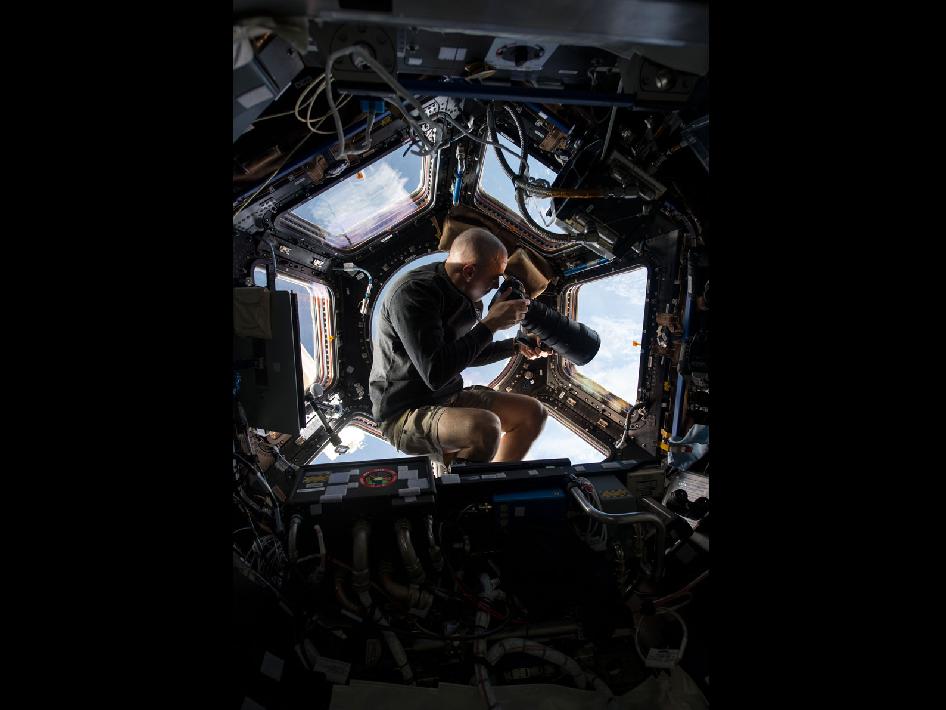
Less than a year since his elevation to Chief of Extravehicular Activity (EVA) and Robotics within the Astronaut Office (Code CB) at the Johnson Space Center (JSC) in Houston, Texas—and only 18 months since he returned from his most recent mission, the 166-day Expedition 35/36 aboard the International Space Station (ISS)—veteran astronaut and seasoned spacewalker Chris Cassidy has been appointed Deputy Chief of the 43-strong active corps. In his new position, Cassidy carries program oversight responsibility for what one space analyst and historian described as “all the big ones, from Capcoms to EVA to Exploration to ISS Ops”. Under the framework of the post-shuttle Astronaut Office, Cassidy is one of two deputies, under the overall leadership of Chief Astronaut Bob Behnken. Cassidy’s former post in charge of EVA/Robotics is now taken by fellow astronaut Ricky Arnold. However, this repositioning of astronaut personnel within the office’s management is timely, since NASA, Boeing and likely SpaceX are expected to assign a “pool” of candidates to the first CST-100 and Dragon V-2 test flights, later this summer.
Boeing and SpaceX secured formal NASA approval in the form of the $6.8 billion Commercial Crew transportation Capability (CCtCap) “pie”, last fall, which will see a pair of U.S.-built spacecraft—the CST-100 and the Dragon V-2, respectively—deliver U.S. astronauts into low-Earth orbit, from U.S. soil, for the first time since the end of the shuttle era. Current plans envisage the two companies staging unpiloted test flights in late 2016 or early 2017, followed by two-person piloted missions to the ISS by mid-2017. It is anticipated that the CST-100 test flight will include one NASA astronaut and one Boeing test pilot, whereas Dragon V-2 will carry an all-NASA crew.
With his new appointment, Cassidy—a veteran of one shuttle mission and one long-duration ISS expedition, with almost 182 days of cumulative time in space and six EVAs, totaling in excess of 31 hours—will take over many of the duties of his predecessor, veteran astronaut Eric Boe, who has served as Deputy Chief of the Astronaut Office since August 2011. Since one of Boe’s roles encompassed Commercial Crew, his is one of several names under consideration for a place aboard one of the early flights of the new vehicles. Others include veteran astronauts Doug Hurley, Rex Walheim, Mike Fincke and Tony Antonelli. “All of the CB leadership jobs are intended to be for three years,” a source close to the Astronaut Office told AmericaSpace, “so it was probably time for Boe to rotate to something else anyway. And if Boeing selects this summer, SpaceX can’t be far behind.”
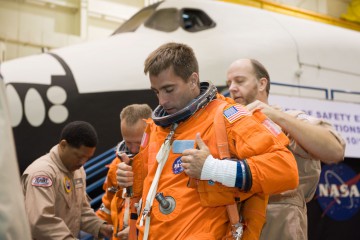
Christopher John Cassidy was born in Salem, Mass., on 4 January 1970, and attended York High School in York, Maine. “It was a quiet beach town and where, in the wintertime, it was relatively small population, and, in the summertime, it was kind of a tourist area for folks from all around—maybe Massachusetts and New Hampshire—to come up and vacation,” he told a NASA interviewer, years later. “I spent a lot of time mowing yards in the summer and playing basketball on the outside beach courts there and it was just a really neat place to grow up.” During his secondary schooling, Cassidy “learned about a place called the Naval Academy, where it’s not only free, but they pay you to go there. What a deal that was!” He graduated from the one-year Preparatory School program in Newport, R.I., in 1989, then earned a degree in mathematics from the academy in 1993.
Mathematics had always come naturally to Cassidy, but it was one of his high school teachers who motivated him not only to pursue it further, but to take his own education more seriously. “I remember at some point in high school having a moment where I saw the light,” he reflected, describing a realization that his studies would allow him to get to college and learn a skill for a lifetime’s career. After graduation, Cassidy completed Basic Underwater Demolition School (BUDS) Class 192 and spent a decade as a U.S. Navy’s famed Sea, Air, Land (SEAL) team, specializing in long-range special reconnaissance (both vehicular and foot patrols), direct-action building assaults, non-compliant ship-boardings, desert reconnaissance, combat diving, underwater explosives and air operations, including parachuting, fast-roping and rappeling. He was deployed to Afghanistan just two weeks after 9/11, in support President George W. Bush’s “War on Terror”. In total, Cassidy participated in four deployments, each six months in duration, traveling twice to Afghanistan and twice to the Mediterranean Sea.
He entered Massachusetts Institute of Technology (MIT) to study for a master’s credential in ocean engineering, which he received in 2000. “I studied underwater vehicles,” he told the NASA interviewer, “specifically underwater vehicle navigation, which is kind of what I was doing in the Navy. I was driving the mini-sub as a navigator, so that was a nice parallel to my graduate studies.” Launching aboard these mini-subs—properly known as SEAL Delivery Vehicles (SDVs)—from the back of a full-size submarine, heading out to a specific location to complete a mission, then returning to the submarine, closely paralleled many of the tasks that Cassidy would one day perform as an astronaut and spacewalker. “Once we submerged, it was just me and my dive buddy, and he’s one of my great friends to this day, Travis McNeese,” Cassidy recalled. “He and I spent hundreds of hours underwater together, solving challenging problems, because it never went right when you got underwater. There was always something breaking or some curveball that’s thrown at you.”
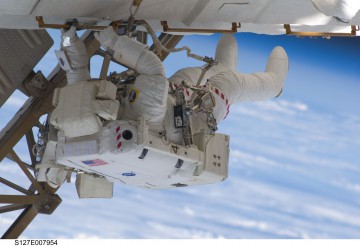
It was during his time as a SEAL that Cassidy encountered NASA astronaut Bill Shepherd, who had also seen action as a Navy SEAL and was an MIT graduate, and it was his words of advice and encouragement that proved a deciding factor. After two years in graduate school, he served as SEAL Platoon Commander at SEAL Team 3 in Coronado, Calif. “It just so happened that our scheduled deployment was supposed to be Thanksgiving of 2001,” he explained. “We were the most-ready SEAL platoon for combat when September 11th happened. Just as luck would have it, that’s the position I found myself in.” Whilst in Afghanistan, he was Ground Assault Force Commander for international and U.S.-only combat missions in the war-torn country and also led two months of non-compliant ship-boardings in the northern Persian Gulf. Returning to the United States in the spring of 2002, Cassidy served as Executive Officer and Operations Officer of Special Boat Team 20 in Norfolk, Va.
Interviewed by NASA in September 2003—just before he deployed overseas—Cassidy was selected as an astronaut candidate in May 2004. He underwent two years of training and evaluation and was qualified as a Mission Specialist in February 2006. Following duty as a Capcom in the Mission Control Center (MCC), and supporting Expedition 15, he was announced as a member of the STS-127 shuttle crew in February 2008. This 16-day mission launched on 15 July 2009 and featured the exchange of long-duration ISS crew members and the installation of Japan’s Exposed Facility onto the Kibo laboratory module. Cassidy performed three EVAs to support the hardware installation and logged more than 18 hours in the vacuum of space, replacing batteries, reconfiguring electrical cables and removing covers from Canada’s Dextre robotic manipulator. “In the training to become a spacewalker and honing our EVA skills, I’ve learned to fall back a lot on the training I gleaned from the Navy and just being comfortable underwater and being comfortable with manipulating things with your hands in a harsh environment,” he told the NASA interviewer. “The comfort level of doing things like that, I really developed that skill in the Navy and it’s very much helped me in my career training for spacewalks.”
Eighteen months after his return from STS-127, in February 2011, Cassidy was formally assigned to begin training for a long-duration ISS increment, named as a member of the Soyuz TMA-08M crew, alongside Russian cosmonauts Pavel Vinogradov and Aleksandr Misurkin, with a targeted launch in March 2013. They would initially form the second half of the six-man Expedition 35—under the command of Canada’s Chris Hadfield and also including Cassidy’s former STS-127 crewmate Tom Marshburn—before rotating into the “core” of Expedition 36, through September 2013.
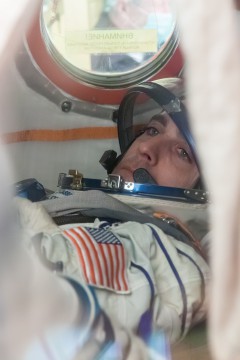
Launched on 28 March 2013, Cassidy and his crewmates became the first Soyuz team to embark on a four-orbit “fast rendezvous” regime, successfully docking at the ISS a mere six hours after liftoff. Just a few days before the return of Hadfield, Marshburn and Russian cosmonaut Roman Romanenko to Earth in mid-May, Cassidy was called upon to perform a contingency EVA to tend to an anomalous ammonia leak from the station’s P-6 truss segment. Together with Marshburn, he worked to replace a suspect Pump Flow Control Subassembly (PFCS). It marked the third occasion that the duo had spacewalked together, having worked in tandem on two of the STS-127 EVAs, four years earlier. Following the return of the old crew, Vinogradov, Misurkin and Cassidy rotated into the core of Expedition 36 and were shortly joined by Soyuz TMA-09M arrivals Fyodor Yurchikhin of Russia, Karen Nyberg of NASA and Italian astronaut Luca Parmitano. In July, Cassidy and Parmitano performed two EVAs. The first of these made history, as Parmitano became Italy’s first spacewalker, whilst the second demonstrated the inherent danger of spacewalking when water intruded into his helmet and required Cassidy to assist him back to the airlock.
Returning to Earth with Vinogradov and Misurkin on 11 September 2013, after 166 days, Cassidy accrued a career total of 181 days and 23 hours in orbit, spread across his two missions, and a cumulative 31 hours and 14 minutes in six EVAs. This currently positions him as the 26th most experienced U.S. astronaut and the 28th most seasoned U.S. spacewalker. Asked if he would like to participate in a future One-Year Mission, Cassidy responded positively. “At a personal level, I wouldn’t mind it,” he told the NASA interviewer. “I would certainly miss my family. It’s a long time, but I have had plenty of friends and good families that have survived year-long deployments, so I know it’s totally a doable thing, but it’s a mental hurdle to get over. If NASA asked me to go, I would probably say yes, but it would certainly be with a lot of discussion inside my house.”
Such an assignment, if it happens, will be further into the future. Upon his return from Expedition 35/36, Cassidy underwent a standard protocol of post-flight rehabilitation, lasting approximately six months, before he was made eligible for further assignments within the Astronaut Office. Last July, the “highly regarded” astronaut was appointed Head of EVA and Robotics—“a major branch” of the office, the source told AmericaSpace, “right up there with Exploration and ISS Ops”—and appears to have held the post until his NASA Biography was updated in March 2015 to include his promotion to Deputy Chief.
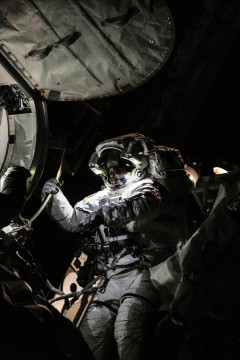
Until the late spring of 2011 and the twilight of the shuttle era, the senior leadership of the Astronaut Office was headed by Chief Peggy Whitson and Deputy Chief Rick Sturckow. However, in August of that year, Whitson extensively reorganized the office to include two deputy positions. One of these was taken by Eric Boe, with long-range development responsibilities focusing on Exploration, Commercial Crew and Safety, whilst the other went to Mike Barratt, with an emphasis on Station Operations, EVA, Robotics and Medical Issues. In January 2012, Barratt was reassigned to manage JSC’s Human Research Program and his post was taken initially by Bob Behnken, who rotated into the role of Chief in August, when Whitson stepped down to return to ISS expedition training.
In the aftermath of this change, Sandy Magnus briefly served as the second deputy, until her retirement from NASA in the fall of 2012. She was replaced in January 2013 by Robert Hanley, the first non-astronaut incumbent of the Deputy Chief post within the Astronaut Office, whose role is described as “oversight of several branches…including International Space Station Integration (Systems), Capsule Communicators, Astronaut Appearances, Contractor Support, Information Technology and Budget”. With almost three decades of experience, Hanley has a wealth of expertise with NASA and United Space Alliance (USA), as a Vehicle Integration Test Engineer, followed by Chief Engineer of the Astronaut Office’s Space Station Branch and, most recently, Manager of the Mission Support Branch of the Office of the Chief Financial Officer.
With the recent management moves, Hanley remains in his post, joined by Cassidy, under the overall direction of Behnken. Yet as Behnken approaches three years in the job, it seems probable that he too may rotate into a new assignment in the foreseeable future. The Astronaut Office has been traditionally led by an active-duty astronaut since Deke Slayton was appointed “Co-ordinator of Astronaut Activities”, way back in September 1962. However, the first “flown” astronaut to serve as Chief was Al Shepard, who held the post from November 1963 through July 1969, whereupon he entered training for the Apollo 14 mission. His shoes were filled by Tom Stafford through June 1971, after which Shepard returned to lead the office for a further 2.5 years, until his retirement from NASA.
Next came John Young—the longest-tenured Chief in history—who ran the corps from January 1974 through April 1987 and oversaw the selection of four classes of new shuttle astronauts. Dan Brandenstein was next, heading the office until October 1992, followed by Robert “Hoot” Gibson until September 1994, Bob Cabana until October 1997, Ken Cockrell until October 1998, Charlie Precourt until November 2002, Kent Rominger until September 2006, Steve Lindsey until October 2009 and Peggy Whitson until August 2012 and the succession of Behnken. As far as Deputy Chiefs are concerned, past incumbents have included shuttle Challenger’s first commander, Paul Weitz, veteran astronaut Linda Godwin, the world’s most experienced female spacewalker, Suni Williams, and future Director of the Flight Crew Operations Directorate (FCOD), Janet Kavandi. Others have moved from the shoes of deputy into the chief’s role, including Kent Rominger and Peggy Whitson.
Want to keep up-to-date with all things space? Be sure to “Like” AmericaSpace on Facebook and follow us on Twitter: @AmericaSpace




Ben, thanks for an informative article. It answers questions I have had for years.
FWIW, note that it is not “JSC’s Human Research Program” but rather a NASA-wide program. It is akin to the ISS Program Office, which also is housed at JSC. The current program manger, Bill Paloski, like Mike Barratt before him, takes direction from Bill Gerstenmaier, not Ellen Ochoa.
JBC
Thank you for the clarification, John.
I had the privilege to meet Cmdr. Cassidy at the Michigan Science Center here in Detroit last year. What a GREAT GUY! He made every person who met him feel as though they were the only ones in the room, very friendly, considerate, personable, and obviously an exceptional individual in every way. Heartfelt CONGRATULATIONS Commander, NASA couldn’t have chosen a better person. It is wonderful to see that America can still produce such individuals of the highest caliber. Thanks for the very interesting and informative article Ben.